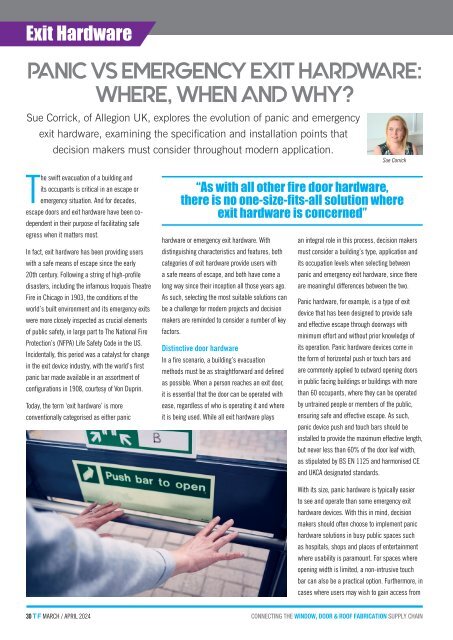March/April 2024
Create successful ePaper yourself
Turn your PDF publications into a flip-book with our unique Google optimized e-Paper software.
Exit Hardware<br />
PANIC VS EMERGENCY EXIT HARDWARE:<br />
WHERE, WHEN AND WHY?<br />
Sue Corrick, of Allegion UK, explores the evolution of panic and emergency<br />
exit hardware, examining the specification and installation points that<br />
decision makers must consider throughout modern application.<br />
Sue Corrick<br />
The swift evacuation of a building and<br />
its occupants is critical in an escape or<br />
emergency situation. And for decades,<br />
escape doors and exit hardware have been codependent<br />
in their purpose of facilitating safe<br />
egress when it matters most.<br />
In fact, exit hardware has been providing users<br />
with a safe means of escape since the early<br />
20th century. Following a string of high-profile<br />
disasters, including the infamous Iroquois Theatre<br />
Fire in Chicago in 1903, the conditions of the<br />
world’s built environment and its emergency exits<br />
were more closely inspected as crucial elements<br />
of public safety, in large part to The National Fire<br />
Protection’s (NFPA) Life Safety Code in the US.<br />
Incidentally, this period was a catalyst for change<br />
in the exit device industry, with the world’s first<br />
panic bar made available in an assortment of<br />
configurations in 1908, courtesy of Von Duprin.<br />
Today, the term ‘exit hardware’ is more<br />
conventionally categorised as either panic<br />
hardware or emergency exit hardware. With<br />
distinguishing characteristics and features, both<br />
categories of exit hardware provide users with<br />
a safe means of escape, and both have come a<br />
long way since their inception all those years ago.<br />
As such, selecting the most suitable solutions can<br />
be a challenge for modern projects and decision<br />
makers are reminded to consider a number of key<br />
factors.<br />
“As with all other fire door hardware,<br />
there is no one-size-fits-all solution where<br />
exit hardware is concerned”<br />
Distinctive door hardware<br />
In a fire scenario, a building’s evacuation<br />
methods must be as straightforward and defined<br />
as possible. When a person reaches an exit door,<br />
it is essential that the door can be operated with<br />
ease, regardless of who is operating it and where<br />
it is being used. While all exit hardware plays<br />
an integral role in this process, decision makers<br />
must consider a building’s type, application and<br />
its occupation levels when selecting between<br />
panic and emergency exit hardware, since there<br />
are meaningful differences between the two.<br />
Panic hardware, for example, is a type of exit<br />
device that has been designed to provide safe<br />
and effective escape through doorways with<br />
minimum effort and without prior knowledge of<br />
its operation. Panic hardware devices come in<br />
the form of horizontal push or touch bars and<br />
are commonly applied to outward opening doors<br />
in public facing buildings or buildings with more<br />
than 60 occupants, where they can be operated<br />
by untrained people or members of the public,<br />
ensuring safe and effective escape. As such,<br />
panic device push and touch bars should be<br />
installed to provide the maximum effective length,<br />
but never less than 60% of the door leaf width,<br />
as stipulated by BS EN 1125 and harmonised CE<br />
and UKCA designated standards.<br />
With its size, panic hardware is typically easier<br />
to see and operate than some emergency exit<br />
hardware devices. With this in mind, decision<br />
makers should often choose to implement panic<br />
hardware solutions in busy public spaces such<br />
as hospitals, shops and places of entertainment<br />
where usability is paramount. For spaces where<br />
opening width is limited, a non-intrusive touch<br />
bar can also be a practical option. Furthermore, in<br />
cases where users may wish to gain access from<br />
30 T F MARCH / APRIL <strong>2024</strong> CONNECTING THE WINDOW, DOOR & ROOF FABRICATION SUPPLY CHAIN
















